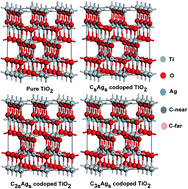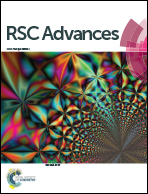Synergistic effect of C, Ag-codoped TiO2 photocatalyst within the GGA + U framework
Abstract
The electronic structures and optical properties of C, Ag-codoped TiO2 were investigated within the GGA + U framework. Different doping concentration and different dopant distance (CsAgs (near and far), C2sAgs (near and far), and C3sAgs (near and far)) models were constructed. According to the formation energy results of these codoped systems, it was found that low concentration codoping was more stable than high concentration codoping. Therefore, we chose the CsAgs (near and far) codoped TiO2 to calculate further electronic structures and optical properties. It was found that near distance codoping could narrow the band gap to 2.81 eV, and far distance codoping decreased the band gap to 2.66 eV. Meanwhile, it was found that far distance codoping preferred to form more localized states near the top of the valence band, while near distance codoping could induce more significant hybrid states in the band gap. Optical property showed that C and Ag codoping could induce a synergistic effect compared with single C and single Ag doping. After codoping, the visible absorption was stronger for both the near and far distance codoped systems than those of the single doped systems, moreover, the far distance codoping configuration could induce both more significant band edge shift and stronger visible optical absorption than that of the near distance codoping configuration.


 Please wait while we load your content...
Please wait while we load your content...